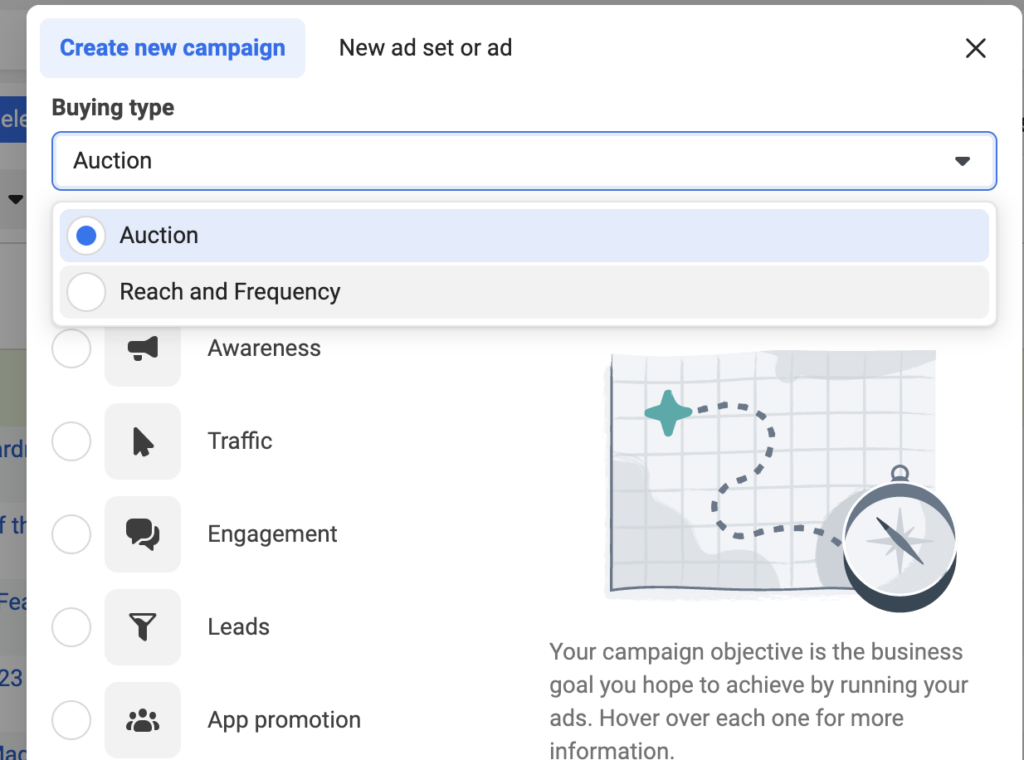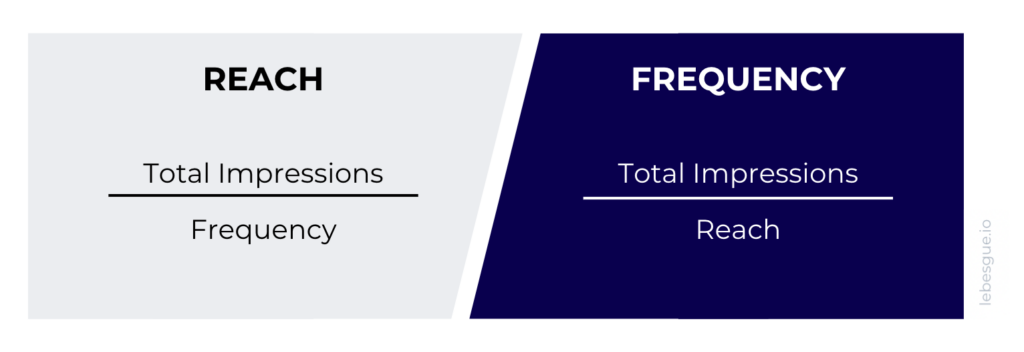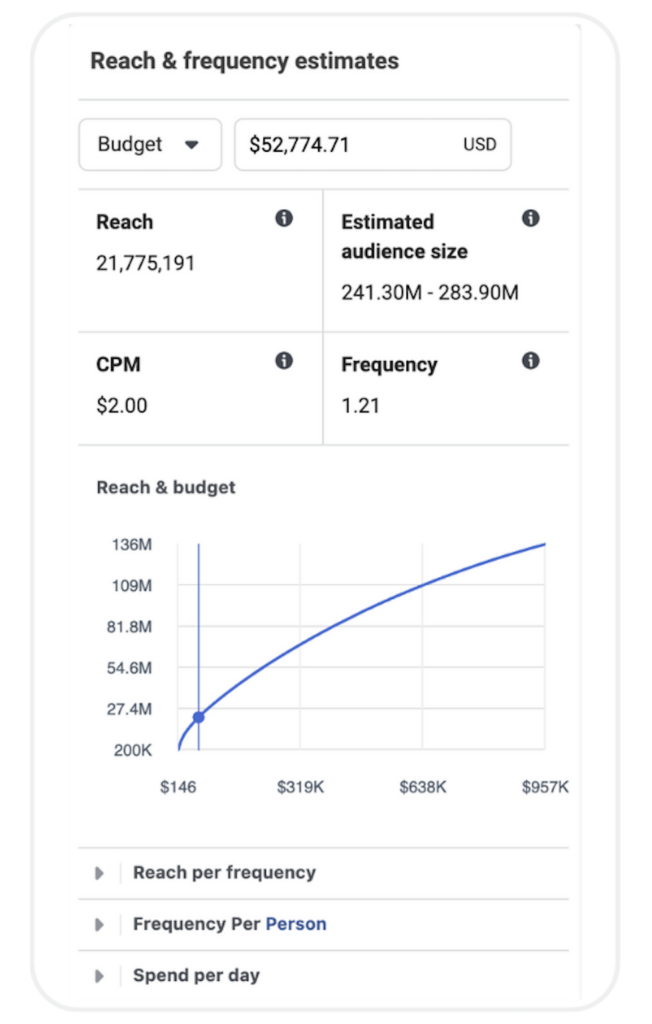When it comes to advertising on Meta, there are two main ways to do it. The first is the auction-style method that many advertisers are familiar with. The second, called Meta’s Reach and Frequency buying type (now called reservation buying type), works quite differently in terms of what you can do with your ads and who you can show them to.
In this blog post, we’ll take a closer look at Meta’s Reach and Frequency options. Whether you’re a seasoned marketer or just starting out, this post will help you understand how Reach and Frequency campaigns can make your advertising efforts on Facebook more effective.
Join us as we explore this unique approach and learn how to use it to reach your advertising goals.
Definition of Reach and Frequency Campaigns
Meta’s Reach and Frequency or reservation buying type campaigns provide advertisers with a way to plan and reserve ad space well in advance. This approach allows them to lock in their advertising costs, specifically known as CPM, and ensures that their message is delivered to a specific audience with a controlled frequency throughout the campaign’s duration.
The significance of this strategy becomes evident in situations where precise message delivery to a defined audience is of utmost importance.
This is particularly crucial during product launches, major announcements, or when introducing a brand or product to new market segments.

Reach and Frequency campaigns help you do three things really well:
Keep your costs predictable
Know exactly who you’re reaching
Control how often people see your ads
With this approach, you can stick to your ad budget—no surprise charges.
You’ll know your message is getting in front of the right people. And you can manage how many times they see it, so you’re not wasting impressions or annoying your audience.
How to Calculate Reach and Frequency?
But how can you calculate Reach and Frequency?
Reach is generally calculated as the total number of unique users who have seen an ad within a specific period. On the other hand, frequency refers to the average number of times the ad was displayed to each person.

How to calculate reach and frequency in advertising?
In digital advertising, these calculations can often be extracted directly from the ad platform’s analytics (like Facebook Insights or Google Ads analytics). Here’s a general guideline:
- Reach: Often provided by the platform based on user data and ad display metrics.
- Frequency: Also typically provided by the platform. However, if you’re running multiple campaigns or ads, you might need to calculate a cumulative frequency by dividing total impressions by the total reach across all campaigns.
How to Set Up Reach and Frequency Campaigns on Meta?
Now, let’s see how you can set up your Reach and Frequency campaign on Meta.
The steps you need to take to set up a campaign correctly are: choose the objective, target audience, placement, ad creative, budget, and schedule, buying type, optimization and delivery, and measurement and analysis.
And that’s it. On buying the type level, you need to choose ‘Reach and Frequency’ for creating this type of campaign.
Meta Ads Optimization for eCommerce store
Many e-commerce stores prefer optimizing their ads for purchase events or leads, especially when using Meta’s conversion and lead generation campaign options. They do this for several good reasons:
- Direct ROI Measurement: This approach lets you easily see how much money you’re making from ads, making it simple to understand if advertising is making a profit.
- Data-Driven Optimization: By using data from tracking pixels, you can make sure your ads are shown to people who are most likely to make a purchase or become potential customers. This means your ad budget is spent on what really matters.
- Retargeting: e-commerce stores often use retargeting ads to bring back people who visited their website but didn’t make a purchase. This aligns perfectly with an ad strategy focused on conversions.
- Dynamic Ads: If an e-commerce store has lots of different products, it can use dynamic ads. These ads automatically show the right products to different groups of people based on what they’ve looked at before. It’s a smart way to boost conversions

Should I run reach and frequency for an e-commerce store?
However, it’s worth noting that while direct response campaigns (like those optimized for purchases or leads) form the backbone of most e-commerce advertising strategies, there are scenarios where Reach and Frequency campaigns could complement these efforts.
- Brand Building:
If you’re running a large store or entering a new market, focus on getting your name out there. Building awareness with a wide audience sets the stage for your future conversion campaigns to perform even better.
- Product Launches:
Launching something new? Make sure as many of the right people as possible hear about it. Controlled reach and consistent messaging help you stay top-of-mind.
- Navigating Competitive Periods:
During busy seasons — like Black Friday or the holidays — conversion-focused ads can get expensive. Mixing in reach campaigns helps you stay visible without draining your budget.
- Positioning and Perception:
Want to shift how people see your brand or highlight your values? Reach and Frequency campaigns help you deliver that message clearly and consistently to a broad audience.
It’s extremely important to note that CPM on reach and frequency ads can be 4-5 times higher than with regular campaigns (meaning that average CPM, which tends to be around $15 in the US, can go over $100), resulting in dramatic cost increases, with no guaranteed success.
Reach and Frequency Metrics
In the context of Reach and Frequency campaigns, CPM is locked in, offering budgetary certainty and ensuring that campaign reach is not compromised by fluctuating ad costs.
Particularly relevant where visibility is key, such as raising awareness among a new target demographic.
While CPM offers insights into visibility and reach, CPC offers a window into engagement, allowing marketers to understand how compelling and relevant users find their ad creatives and messages.
Ensuring a healthy CPC within Reach and Frequency campaigns implies maintaining an engaging and relevant message, even while prioritizing reach and visibility.

Wondering what kind of performance to expect from your Meta campaigns? With Lebesgue’s AI-powered forecasting, you can estimate campaign outcomes based on your historical data — helping you confidently decide whether a Reach and Frequency campaign is the right move before committing budget.
Factors influencing CPM in reach and frequency campaigns
In Reach and Frequency campaigns, you can lock in ad placements at a fixed cost, ensuring their ads appear as planned.
However, during peak periods like holidays, when ad slots are in high demand, securing these placements might come at a higher CPM to outbid the competition.
When it comes to premium ad inventory, these are the placements that perform exceptionally well or are in high demand, such as those on Facebook, Instagram, or the Audience Network. These sought-after spots might also have higher CPMs as advertisers compete to claim them.
Audience competition plays a vital role in determining CPM rates.
If the targeted audience is in high demand, such as a demographic with strong purchasing power, securing a reach within that segment could necessitate a higher CPM to win the ad spots.
Additionally, Reach and Frequency campaigns are often employed to reach a wide audience across a platform. Ensuring that the message reaches a broad section of the intended demographic may sometimes require a higher CPM, particularly in competitive industries where advertisers are vying for the same audience’s attention.

Auction vs. Reach and Frequency
Auction buying on Meta provides flexibility and is commonly used for various campaign objectives, allowing ongoing edits and optimizations with costs subject to demand and competition.
On the other hand, Reach and Frequency buying allows advertisers to secure ad placements in advance, offering controlled, predictable ad delivery and fixed costs, suitable for large-scale campaigns where assured reach and message frequency are pivotal.
Your choice between the two should hinge on your campaign goals, budget, and the necessity for either flexibility or controlled, predictable delivery.
- Auction-Based Buying:
- Dynamic Pricing: The cost is determined by the competitive landscape and is not fixed.
- Flexible: Can adjust campaigns on the fly based on performance.
- Target: Often used for conversion-oriented campaigns.
- Reach and Frequency Buying:
- Fixed Pricing: CPM is fixed, providing cost certainty.
- Predictability: Ensures message is delivered to a defined audience with controlled frequency.
- Less Flexibility: Modifications after booking may be limited.
- Target: Suited for campaigns where controlled messaging and wide reach are crucial, like brand awareness campaigns.
Summing Up
Reach and Frequency campaigns might seem like a good idea for spreading the word wide and controlling how often your audience sees your ads. But for eCommerce, especially for smaller players, it might not be the best choice.
Why? It’s simple: it’s expensive and doesn’t guarantee the sales or leads that businesses often need to see where their money is going.
Paying more for impressions, without a direct link to tangible results like purchases, might not be the smartest move when you’re trying to grow your business and keep the cash flow positive.



